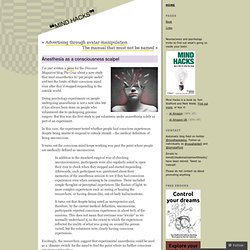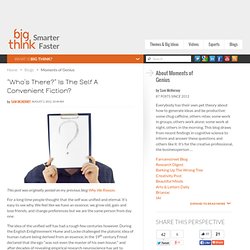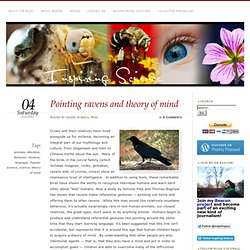

Preserved Feedforward But Impaired Top-Down Processes in the Vegetative State. Anesthesia as a consciousness scalpel. I’ve just written a piece for the Discover Magazine blog The Crux about a new study that used anaesthetics to “put people under” and test the limits of their conscious mind even after they’d stopped responding to the outside world.

Doing psychology experiments on people undergoing anaesthesia is not a new idea but it has always been done on people who volunteered due to undergoing genuine surgery. But this was the first study to put volunteers under anaesthesia solely as part of an experiment. In this case, the experiment tested whether people had conscious experiences despite being unable to respond to outside stimuli – the medical definition of being unconscious. It turns out the conscious mind keeps working way past the point where people are medically defined as unconscious.
In addition to the standard surgical way of checking unconsciousness, participants were also regularly asked to open their eyes to check when they stopped and started responding. More at the link below. “Who’s There?” Is The Self A Convenient Fiction? This post was originally posted on my previous blog Why We Reason.

For a long time people thought that the self was unified and eternal. It’s easy to see why. We feel like we have an essence; we grow old, gain and lose friends, and change preferences but we are the same person from day one. The idea of the unified self has had a rough few centuries however. During the English Enlightenment Hume and Locke challenged the platonic idea of human nature being derived from an essence; in the 19th century Freud declared that the ego “was not even the master of his own house;” and after decades of revealing empirical research neuroscience has yet to reveal anything that scientists would call unified. One of the most dramatic demonstrations of the illusion of the unified self comes from Michael Gazzaniga, who showed that each hemisphere of the brain exercises free will independently when surgeons cut the corpus callosum.
Demonstrations of silencing, a visual illusion. Allan Jones: A map of the brain. Dan Dennett on our consciousness. Antonio Damasio: The quest to understand consciousness. Pointing ravens and theory of mind « Inspiring Science. Crows and their relatives have lived alongside us for millenia, becoming an integral part of our mythology and culture, from Gilgamesh and Odin to Chinese myths about the sun.

Many of the birds in the corvid family (which includes magpies, rooks, jackdaws, ravens and, of course, crows) show an impressive level of intelligence. In addition to using tools, these remarkable birds have shown the ability to recognize individual humans and warn each other about “bad” humans. Now a study by Simone Pika and Thomas Bugnyar has shown that ravens make referential gestures — pointing out items and offering them to other ravens. While this may sound like relatively mundane behaviour, it’s actually surprisingly rare in non-human animals; our closest relatives, the great apes, don’t seem to do anything similar. Referential gestures such as pointing are also a good example of another aspect of theory of mind. Ref: Pika, Simone & Bugnyar, Thomas. (2011) Pika, S., & Bugnyar, T. (2011). Like this: Oliver Sacks: What hallucination reveals about our minds.